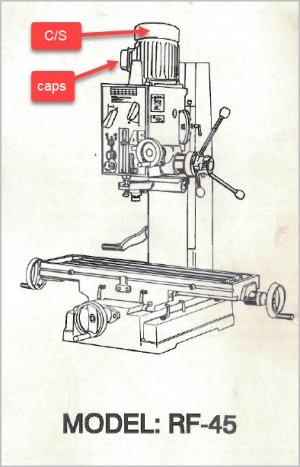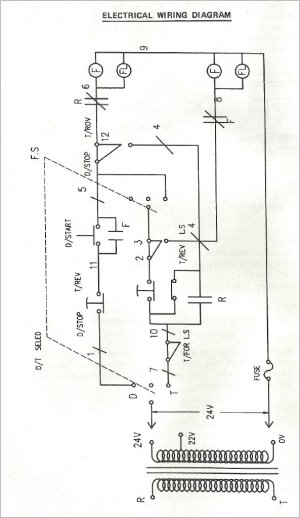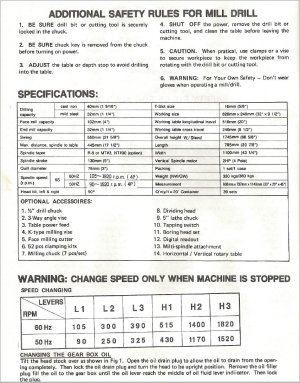Downwindtracker2
Well-Known Member
Any idea of what these connections go to ? And how to find out ?
l'm Looking to be able to learn about wiring the motor on my RongFu-45 mill/drill . I bought a couple of well used Taiwanese machines, a DF1224g lathe and the RF-45 . Just $1700 for the pair. Used RF-45s were going for at least $1500 at the time. . Obviously, they had problems, both had mickey mouse electrical repairs. The lathe got a Baldor 3phase 2hp and a Hitachi VFD . I'll use the mag starter off the lathe and a SquareD drum switch for reversing. Both are 2hp rated. The motor is a " Capacitor AC Induction Motor" 2hp 1ph 1725rpm 10.5amp 2001 date. I have 220volts.
I'm a 73 old retired millwright and am willing to learn something new. At my age it's pretty slow learning, though, chuckle. Not like half a century ago. Once you understand something, it's simple .I ,then, can follow a schematic . I know single phase motors work start with starting windings and have run windings . BTW computers are not on my list of skill sets, so I'll just have to list the input wire colours and pins with their motor wire numbers on the junction box six pin block.
top row
white- #6
yellow-#1
----- #5#3#2 connected together
bottom row
red-#4
not used
black- no number
What do these wire numbers go to? These were on the inside of the lid.
There is a circuit breaker. I wonder what it connects between ?
The previous owner had a light switch hooked up, as I said, it was mickey mouse. I used the drum switch as on/off and followed his wiring. She has almost paid for herself. But it's time to fix the electrical problem and some more of the mechanical issues. I think it had been CNCed before he got it. He was a cabinetmaker and used it on some design run.
l'm Looking to be able to learn about wiring the motor on my RongFu-45 mill/drill . I bought a couple of well used Taiwanese machines, a DF1224g lathe and the RF-45 . Just $1700 for the pair. Used RF-45s were going for at least $1500 at the time. . Obviously, they had problems, both had mickey mouse electrical repairs. The lathe got a Baldor 3phase 2hp and a Hitachi VFD . I'll use the mag starter off the lathe and a SquareD drum switch for reversing. Both are 2hp rated. The motor is a " Capacitor AC Induction Motor" 2hp 1ph 1725rpm 10.5amp 2001 date. I have 220volts.
I'm a 73 old retired millwright and am willing to learn something new. At my age it's pretty slow learning, though, chuckle. Not like half a century ago. Once you understand something, it's simple .I ,then, can follow a schematic . I know single phase motors work start with starting windings and have run windings . BTW computers are not on my list of skill sets, so I'll just have to list the input wire colours and pins with their motor wire numbers on the junction box six pin block.
top row
white- #6
yellow-#1
----- #5#3#2 connected together
bottom row
red-#4
not used
black- no number
What do these wire numbers go to? These were on the inside of the lid.
There is a circuit breaker. I wonder what it connects between ?
The previous owner had a light switch hooked up, as I said, it was mickey mouse. I used the drum switch as on/off and followed his wiring. She has almost paid for herself. But it's time to fix the electrical problem and some more of the mechanical issues. I think it had been CNCed before he got it. He was a cabinetmaker and used it on some design run.




